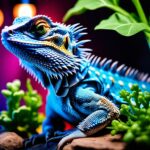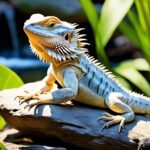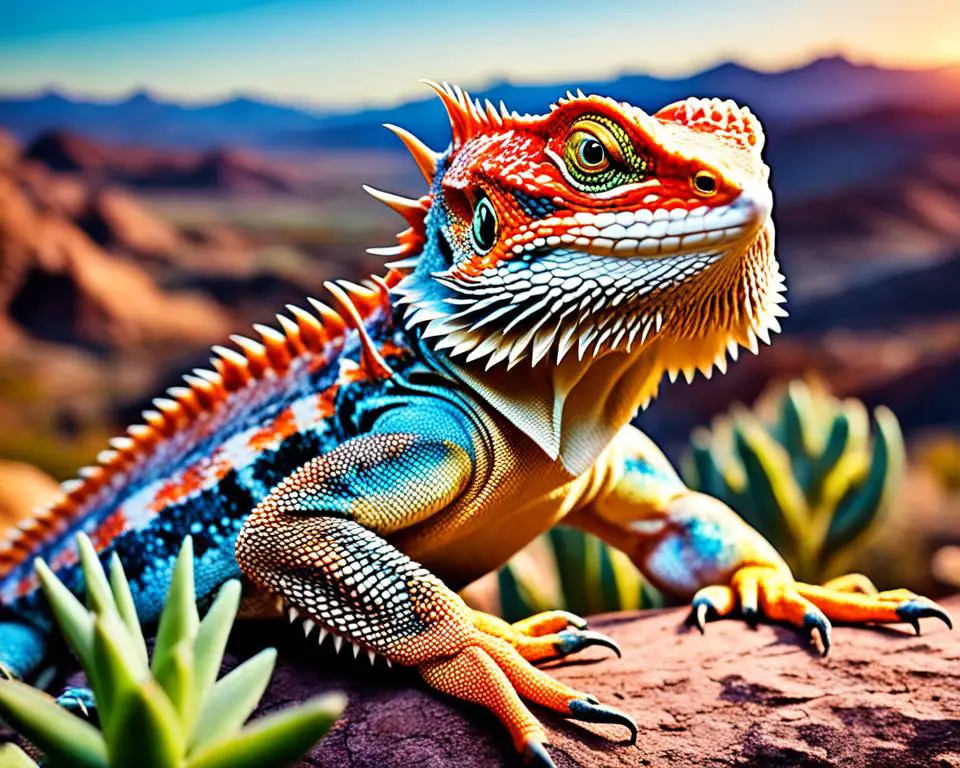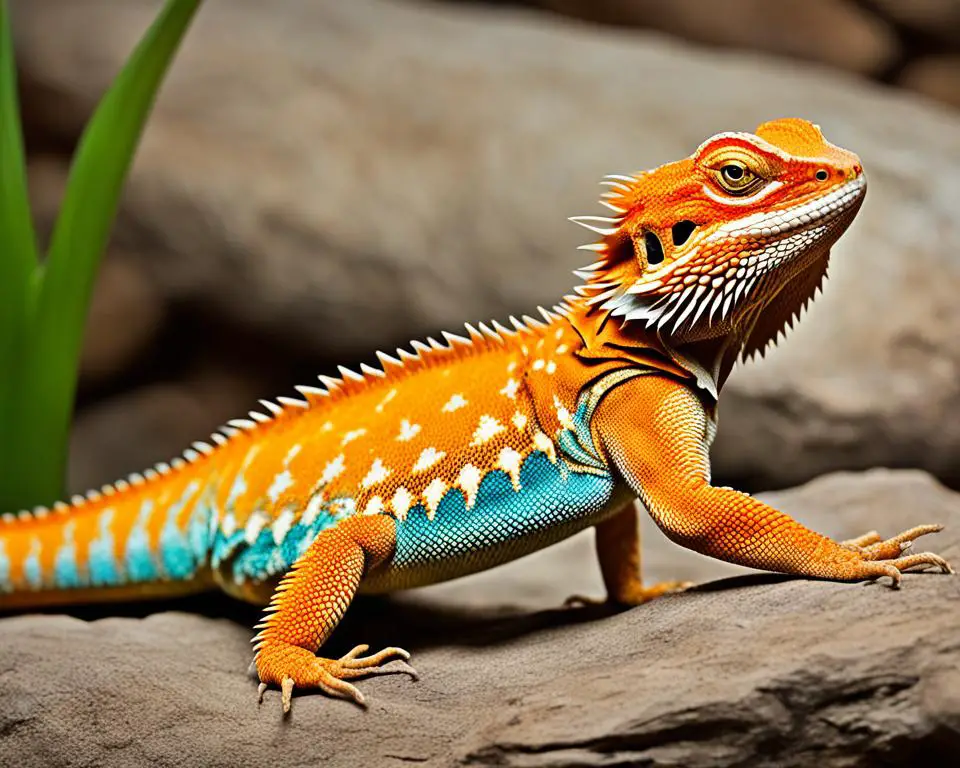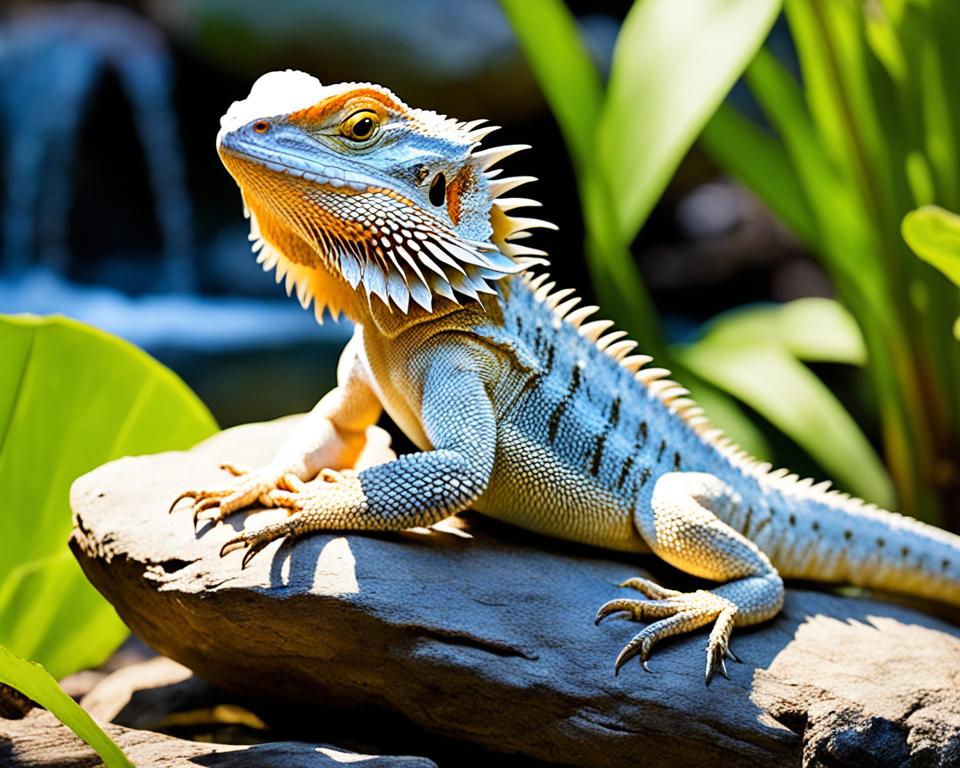Welcome to the world of Red Monster Bearded Dragons, a vibrant addition to pet reptiles. These pets stand out with their bright red color, making them highly desired. They are not found in nature, adding to their allure. Their unique beauty and friendly nature make them special.
This guide is for both new and experienced reptile owners. It covers the care, traits, and joys of having a Red Monster Bearded Dragon. Learn why these reptiles are so loved and get tips on caring for them.
Introduction to Red Monster Bearded Dragons
Red Monster Bearded Dragons are a special type of bearded dragon known for their bright red look. They have vibrant colors that draw in reptile lovers and make great pets. They are easy to care for, making them perfect for both new and experienced owners.
These dragons stand out in their terrariums with their bright color and fun personalities. They are not just pretty; they also have unique traits that make them interesting.
The hypo trait in bearded dragons means they have less melanin, making their colors more vivid. Hypo bearded dragons have clear nails and bright colors. The translucent trait gives them see-through skin and different eye colors, adding to their charm.
Paradox bearded dragons have patches that look like paint, making each one unique. This adds to their appeal for reptile fans.
The Red Monster morph is known for its bright red color. These dragons can have colors from fire engine red to softer maroons and pinkish tones. This makes them very popular among collectors.
True orange and yellow bearded dragons, including citrus shades, are also highly desired for their bright colors.
Knowing how to care for these dragons is key. When breeding, traits like hypomelanism and clear nails can be seen early on. With the right care, Red Monster Bearded Dragons can be beautiful and loving pets.
Appearance and Color Variations
Red Monster Bearded Dragons are known for their bright colors. They come in many striking patterns. These dragons range from deep ruby to fire engine red, making them stand out. Breeders like Robert Gonzalez at 7th Galaxy Dragons have worked hard to create these unique colors and patterns.
Striking Red Hues
Red bearded dragons are more than pets; they’re visual wonders. They can be deep blood-red or bright fire engine red. This makes them a favorite among those who love adding color to their collections. Through careful breeding, each red bearded dragon becomes truly one-of-a-kind.
Comparison with Other Bearded Dragon Colors
Red bearded dragons are unique among other bearded dragon colors. While most are brown, gray, yellow, or orange, red stands out. Rare morphs like paradox and hypo zeros add to their appeal with unique patterns.
They also contrast with witblits, which are pale and lack patterns. This shows just how diverse bearded dragon colors can be.
| Color Morph | Characteristics |
|---|---|
| Red | Deep ruby to fire engine red hues |
| Yellow | Solid yellow to dark yellow, commonly bred |
| Paradox | Color splotches resembling splattered paint |
| Hypo Zero | Paper-white or silver-gray color |
| Witblits | Pale, patternless appearance |
Are Red Monster Bearded Dragons Rare?
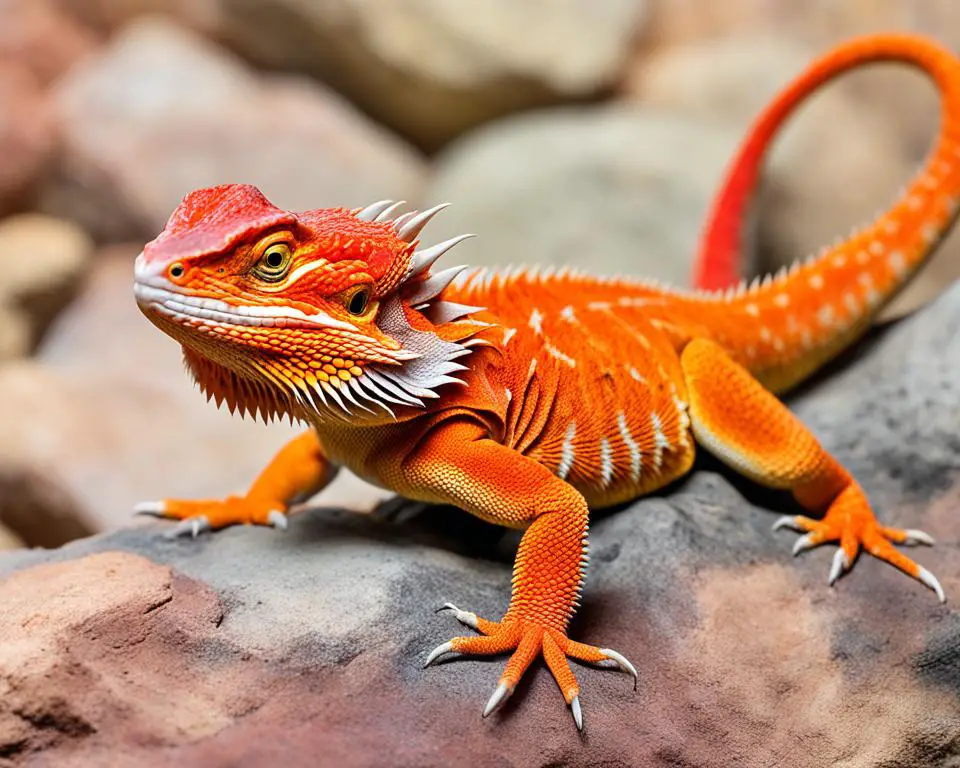
Red Monster Bearded Dragons are not the rarest but are still sought after. Their bright red color makes them stand out from common ones like the yellow bearded dragons. Breeders work hard to make these vibrant reptiles.
People who love reptiles and collectors look for Red Monster Bearded Dragons on MorphMarket. If you’re willing to invest time and resources, you can own this unique pet.
Buying and shipping a Red Monster Bearded Dragon costs a bit more because they’re semi-rare:
| Description | Cost |
|---|---|
| FedEx Overnight Priority Delivery | $47.95 |
| Box & Packaging Fees | $12.00 |
| Live Insects (first quantity) | $15.95 |
| Live Insects (additional quantities) | $7.95 |
| Frozen Feeders | $39.95 (flat rate) |
Breeders work hard to create Red Monster Bearded Dragons. They focus on specific traits to produce these stunning dragons. This effort makes these dragons highly sought after.
But, buying and shipping live animals comes with rules and costs. You might need health certificates in some places and shipping can be pricey.
In summary, Red Monster Bearded Dragons are not super rare but they’re still special. Their unique look and the effort to breed them keep them in demand.
Size and Growth of Red Monster Bearded Dragons
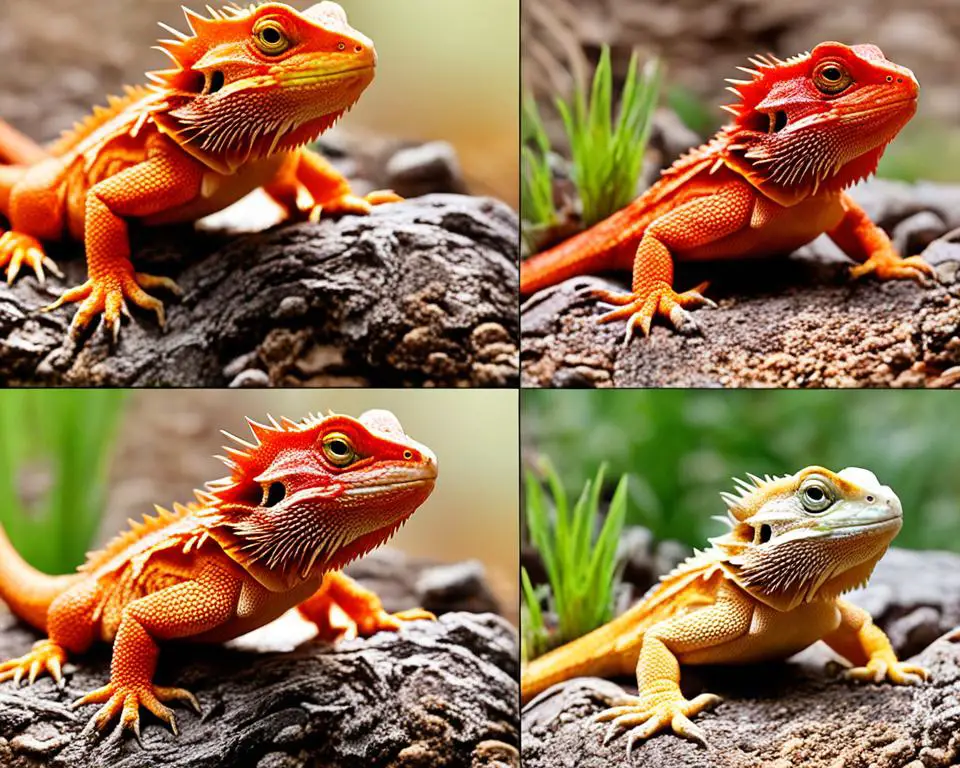
Knowing about reptile size and bearded dragon growth is key for their pet health. The size of a Red Monster Bearded Dragon shows how well they are doing. It also helps make sure they grow into healthy adults.
Typical Size Range
Red Monster Bearded Dragons usually grow to be 18 to 24 inches long, including their tail. This size is similar to other bearded dragon types. They need a big space to live, like a 120-gallon tank (4′ x 2′ x 2′) for adults. This gives them room to grow and stay healthy.
Factors Influencing Growth
Many things can affect bearded dragon growth, like what they eat and where they live. Red Monster Bearded Dragons need a diet of mostly vegetables and some live food to grow right. Companies like Zen Habitats make special enclosures that help them grow. These enclosures are like their natural homes in the trees.
| Factor | Details |
|---|---|
| Nutrition | A balanced diet of 80% vegetables and 20% live food for adults. |
| Enclosure Size | Minimum of 120 gallons for adults to enable appropriate movements and growth. |
| Temperature Regulation | Providing a temperature gradient in their enclosure, with basking spots reaching 120-130°F. |
| Humidity | Maintaining a humidity level of 30-40% to support healthy growth. |
Cost of Owning a Red Monster Bearded Dragon
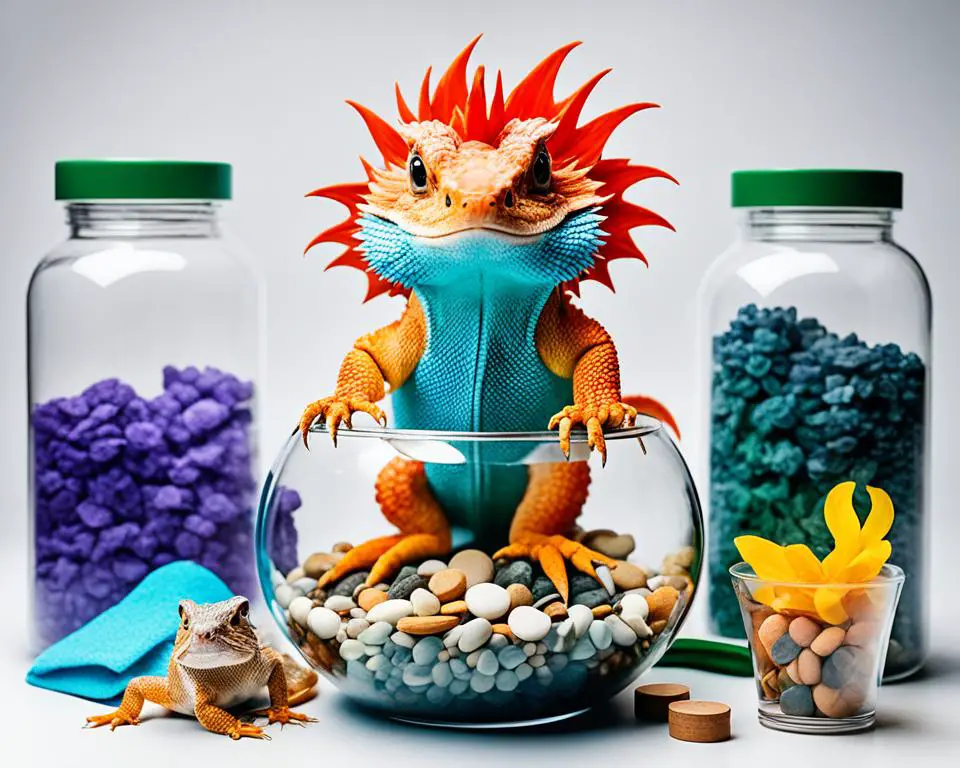
Owning a Red Monster Bearded Dragon is more than just buying one. You need to think about the bearded dragon price, reptile maintenance cost, and pet ownership expenses. We’ll look at the costs you’ll face at the start and what you’ll spend later to keep your bearded dragon healthy and happy.
Initial Purchase Price
The price of a baby Red Monster Bearded Dragon ranges from $50 to $100. For more vibrant red morphs, prices can be $200 to $500 or more. On MorphMarket, prices can go from $100 to $8000, especially for those with a red monster lineage.
Don’t forget the initial setup costs. You’ll need a 120-gallon PVC enclosure, heating, and lighting equipment. These costs add up to about $765.
Recurring Costs and Maintenance
After setting up, you’ll face ongoing costs for reptile maintenance and pet ownership. Keeping the enclosure clean is key. A 55-gallon tank is the minimum size for an adult bearded dragon, providing enough space. Sand or fine gravel bedding is both affordable and easy to clean.
Keeping the right temperature is important. Daytime temperatures should be between 76°F to 86°F, with a basking area up to 100°F. At night, it should be in the low to mid 70s. UV lighting helps with calcium absorption and should be replaced regularly.
Food costs will also add up. Bearded dragons eat insects and vegetables, so fresh food is a must. Regular vet visits for check-ups and illnesses are part of the ongoing costs.
These costs show the importance of budgeting for both the start and ongoing expenses. This helps ensure your Red Monster Bearded Dragon stays healthy and happy.
Diet and Nutrition for Red Monster Bearded Dragons
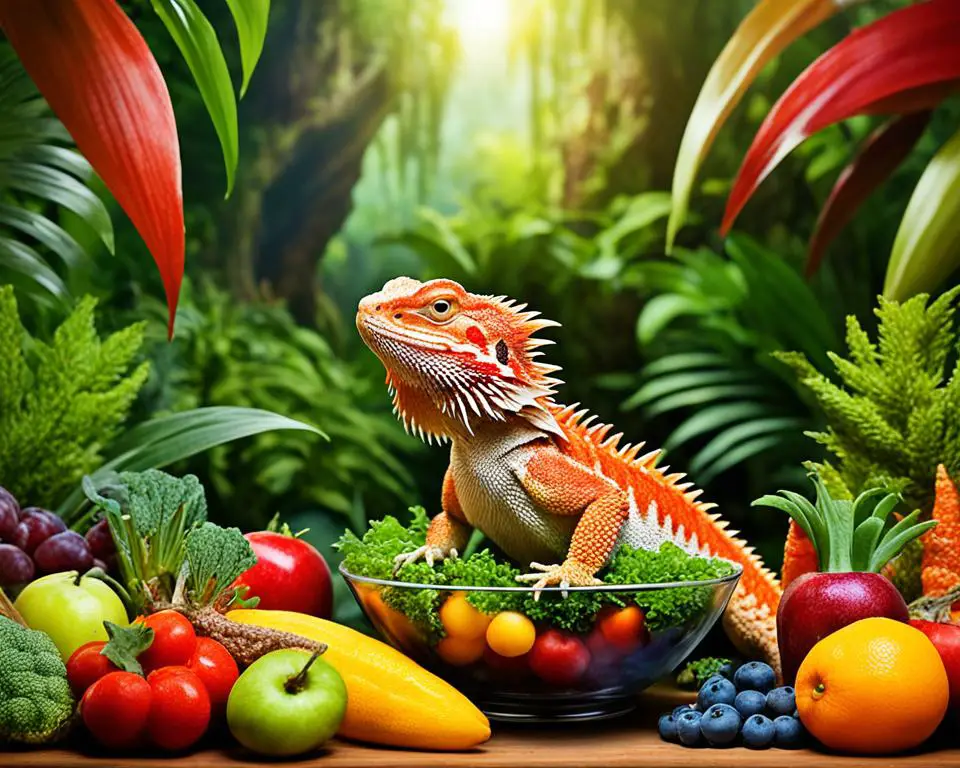
It’s key to know what to feed your bearded dragon to keep it healthy and long-lived. Red Monster Bearded Dragons need a mix of insects and plants to do well. A balanced diet helps avoid sickness and keeps your pet happy and active.
Insect-Based Diet
Feeding young bearded dragons lots of insects is crucial. They eat about 80% insects and 20% plants when they’re young. As they grow, this changes to a 50-50 mix. Common insects to feed them include:
- Crickets
- Roaches
- Mealworms
- Earthworms
- Silk worms
Adult bearded dragons eat fewer insects, about 20%. It’s smart to feed them insects that are rich in nutrients. Avoid giving them elderbugs and fireflies.
Vegetable and Green Requirements
Adult bearded dragons should eat mostly plants, around 80%. Leafy greens like collard greens, kale, and mustard greens are a must. These greens give them the vitamins and minerals they need. Fruits like apples, blueberries, and grapes can also be given, but not too much, about 10-20%.
Don’t give bearded dragons lettuce, mushrooms, or wild plants as they can cause stomach problems and aren’t good for them.
Supplementation Needs
Supplements are a must for your Red Monster Bearded Dragon’s diet. They need a daily phosphorus-free calcium powder to keep their bones strong. UVB lighting helps them get calcium from their food. And, make sure they always have fresh water to drink.
Behavioral Traits and Temperament
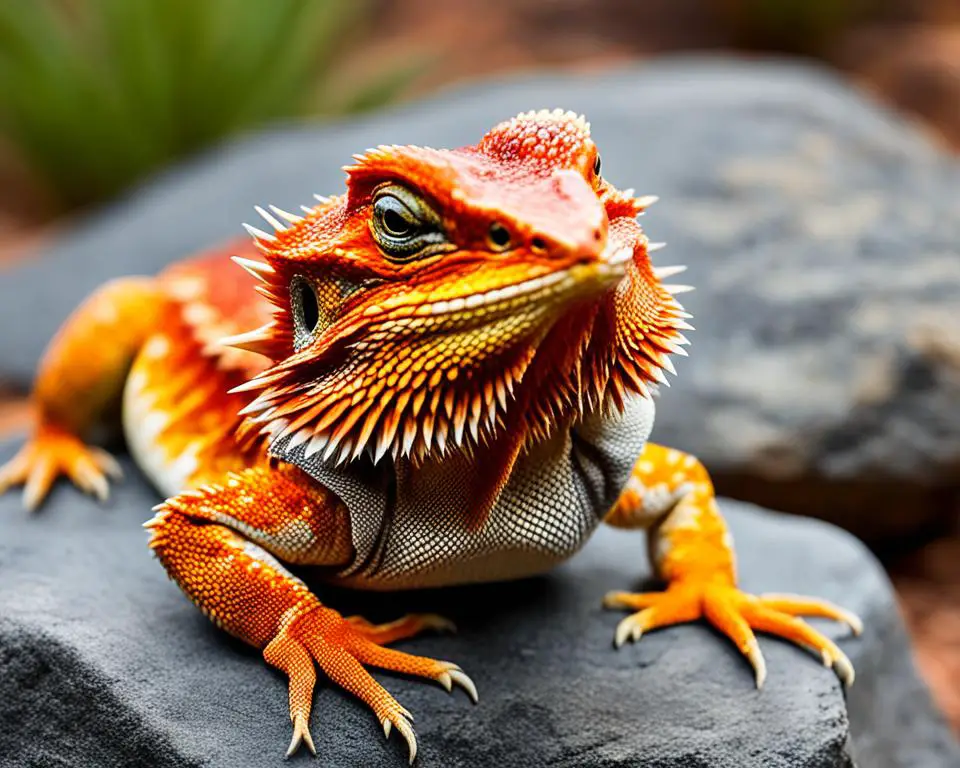
Learning about the behavior of Red Monster Bearded Dragons can make owning one more rewarding. These dragons are calm and gentle, making them a favorite among reptile lovers. They are known for being friendly and may even show love to their owners.
Interaction with Owners
Red Monster Bearded Dragons are great at interacting with people. They can recognize their owners and may even react when they see them. Handling them from a young age helps them get used to being around humans, making interactions less stressful.
They are also easy to be around, making them perfect for both new and seasoned reptile owners.
Dominance and Mating Behaviors
Red Monster Bearded Dragons show interesting behaviors during mating season. Males may turn their beards black to show dominance. They also perform courtship rituals like head-bobbing and arm-waving.
It’s important to create a safe space for these behaviors. This means not keeping multiple males together to prevent fights.
The Red Monster Bearded Dragon is a unique and interesting pet. They offer a special bond through positive interactions with their owners.
Housing and Enclosure Setup
Creating the perfect home for your Red Monster Bearded Dragon needs careful thought. You must consider the size of the enclosure, how to control the temperature, and what to add for fun. Following the right guidelines and adding important items to their home is key for your pet’s health.
Optimal Enclosure Size
The Reptiles and Research suggest a minimum size of 4’x2’x2’ft for adult bearded dragons. But, a bigger space is better for their comfort and growth. They suggest a 6’x2’x3’ft or 7’x2’x2’ft enclosure. The Federation of British Herpetologists also recommend a size based on the dragon’s length.
For example, a 20cm long bearded dragon needs a 120 x 60 x 60cm enclosure. A 25cm long adult male should have a 5’ x 2.5’ x 2.5’ft space.
Importance of Temperature Regulation
Keeping the right temperature is crucial for your bearded dragon’s health. About 70-80% of reptiles need heat to stay warm. Bearded dragons need a warm spot and a cooler area in their home.
The warm spot should be between 108-113°F (42-45°C). The cooler side should be 77-85°F (25-29°C). At night, it’s okay to cool down to 50°F to make them more active during the day.
Strong and reliable UVB lighting is also a must. Bearded dragons need this light to make vitamin D3, which helps with calcium. Good UVB bulbs include the Arcadia T5 HO Desert 12%, Zoo Med T5 HO Reptisun 10.0, and Arcadia T5 HO Dragon 14%.
Decor and Enrichment
An interesting home is key for your bearded dragon’s happiness. Adding things to climb on, places to hide, and natural decorations helps them feel at home. Mixing real and fake decorations makes their space fun and cozy.
In short, a great bearded dragon home has the right size, temperature control, and fun things to do. This makes for a happy and healthy pet.
Health and Wellness
Keeping Red Monster Bearded Dragons healthy means paying close attention to their care. It’s important to take both proactive and reactive steps. By doing so, you can prevent and manage health issues effectively. Let’s look at the common health problems and how to keep your dragon healthy.
Common Health Issues
Red Monster Bearded Dragons face many diseases that can lower their quality of life. Some of these include:
- Metabolic bone disease (MBD): This happens when their diet lacks calcium or vitamin D3. It can lead to bone problems and fractures.
- Parasites: Parasites like pinworms can cause diarrhea and weight loss. Checking their stool often helps catch these early.
- Atadenovirus: This virus is common in young dragons and can affect their liver and stomach.
- Infectious stomatitis (mouth rot): This is a serious infection of the gums and jaw if not treated.
- Respiratory infections: These can come from bad living conditions or stress. Look for fast breathing and nasal discharge.
- CANV (Chrysosporium anamorph of Nannizziopsis vreisii): A fungal infection that looks like thick yellow skin patches, needing quick treatment.
Preventive Care and Regular Check-ups
Preventing health problems is key to keeping reptiles healthy. Regular veterinary check-ups help spot issues early and get them treated quickly.
Here are some tips for preventing health issues:
- Feed them a diet full of calcium and vitamin D3, but avoid foods high in phosphorus like spinach.
- Give young dragons lots of crickets and adults a mix of live insects and veggies. Don’t give them lettuce because it’s not very nutritious, and cook squash to make it easier to digest.
- Keep their living area clean and humid to stop respiratory infections.
- Watch for signs of sickness, like eating less, being tired, or having visible bone problems.
- Make sure they have the right UVB lighting to keep their bones and metabolism healthy.
For more bearded dragon care advice, check out guides that cover diet and habitat needs.
Choosing the right gear and setting up a good home can lower health risks. This helps your pet live a longer, healthier life. Using services like PetSmart can help you get what you need without spending too much.
Preventative care and making smart choices are key to your reptile’s health. This way, your Red Monster Bearded Dragon can live a happy and healthy life.
Breeding Red Monster Bearded Dragons
Breeding Red Monster Bearded Dragons requires careful attention to ensure their health and color vibrancy. These reptiles stand out with their bright red colors, making them a favorite in reptile breeding. It’s important to know about genetic diversity and ethical breeding practices for success.
For those looking to breed Red Monster Bearded Dragons, it’s key to understand the different bearded dragon morphs that make them unique. These include:
- Hypomelanism (Hypo): This is a recessive trait that lowers melanin, making nails clearer and scales lighter.
- Translucent (Trans): This mutation makes the skin partially see-through and the eyes solid black.
- Paradox: This trait brings random color patches without any pattern.
- Dunner: It changes the typical stripes to unique spots and patterns.
When breeding, consider the health effects of your choices. Overbreeding for certain traits, like blue or purple in trans dragons, can lead to health problems. However, careful pairings can result in healthy and strong adults. This shows the need to keep the genetic health of the dragons while aiming for beauty in reptile breeding.
| Trait | Description |
|---|---|
| Hypomelanism (Hypo) | Decreased melanin production, resulting in clearer nails and lighter scales. |
| Translucent (Trans) | Partially see-through skin and solid black eyes. |
| Paradox | Random color patches with no symmetrical patterns. |
| Dunner | Unique spots and distinctive patterns replacing usual stripes. |
The red bearded dragon morph is highly desired and comes from selective breeding. Prices for these dragons range from $100 to $8000. Ensuring quality and ethical breeding practices is crucial. Choosing and pairing dragons carefully can help maintain or improve their vibrant red color.
It’s vital to provide the right housing for Red Monster Bearded Dragons, especially after mating. They are territorial. Separate housing keeps each dragon safe and supports a successful, ethical breeding program.
History and Origin of Red Monster Bearded Dragons
The story of the Red Monster Bearded Dragon is quite interesting in the world of bearded dragons. These colorful reptiles are a part of Australia’s rich reptile heritage. They catch the eye with their bright red and orange scales. Originally from Australia’s dry areas, they have changed a lot because of selective breeding by humans.
This change has given them their unique red color. Now, they are favorites among those who keep them as pets.
Native Habitat in Australia
Red Monster Bearded Dragons come from Australia’s dry and arid lands. They live in places with little water and lots of desert plants. These reptiles have learned to survive in tough conditions.
They use their beards for protection and warm up in the sun to keep their body temperature right. The dry climate of Australia affects their looks, behavior, and where they live.
Development of the Red Morph
The Red Monster Bearded Dragon’s bright red color comes from careful breeding. Breeders picked out dragons with the most vibrant red and orange scales. This made these colors more common over time.
Websites like Hiking Reptile and Biblical Dragons show off these beautiful reptiles. They also talk about the success of mixing different dragon colors. Mixing with other colors like het wero dragons keeps the dragons healthy and diverse.
This breeding program has brought us the stunning Red Monster Bearded Dragon. It combines the beauty of Australian reptiles with modern science. Breeders work hard to keep these amazing creatures alive and looking great, whether in the wild or in captivity.
Conclusion
Getting a Red Monster Bearded Dragon as a pet is thrilling. It’s a mix of exotic beauty and loving companionship. These reptiles can grow up to 24 inches long and live for 10-15 years with the right care. They eat mostly insects and leafy greens, and their bright red color shows they are healthy and lively.
It’s key to take good care of these dragons for them to do well. They need the right lighting, heat, and a big tank. Knowing about health issues like metabolic bone disease and respiratory infections helps with early care and check-ups. Watching their special behaviors, like head bobbing and arm waving, can also make the bond stronger.
It’s vital to know about the strong community and resources for Red Monster Bearded Dragon fans. There are online forums, social media groups, and local clubs full of support and advice. By following this bearded dragon care guide, new owners will give their pet a great life. They’ll also get to enjoy having a Red Monster Bearded Dragon as a family member.
Source Links
- Red Bearded Dragon: Facts, Health, Pictures & Care Guide
- Dragons & Mythical Creatures Directory
- A Look Back at Disney Dragons
- A Guide to Bearded Dragon Mutations and Genetic Traits — HereBDragons.com
- Breeding Bearded Dragon Morphs – Reptiles Magazine
- Bearded Dragon Morphs, Colors & Patterns
- A Beginner’s Guide to Bearded Dragon Colors & Morphs
- COLORS & MORPHS
- Types of Bearded Dragons » View Different Types, Colors, & Species
- Red Bearded Dragons
- Red Hypo Translucent Bearded Dragon
- Fire and Ice Dragons
- Red Bearded Dragon Care Guide: Diet, Habitat, FAQs, & More!
- Red Bearded Dragon Mastery: Is This Morph Right For You?
- Pogona
- red monster bearded dragon/red monster bearded dragon for sale
- Bearded Dragons For Sale – Imperial Reptiles
- The Complete Bearded Dragon Diet Plan. Keep Your Pet Healthy and Happy
- Red Hills Veterinary Hospital
- Feeding Bearded Dragons | VCA Animal Hospitals
- What Morphs Do Bearded Dragons Come In?
- 22 Types of Bearded Dragon Morphs & Colors (With Pictures!)
- Bearded dragons
- Bearded Dragon Care Guide — Reptiles and Research
- The Ultimate Guide to Heating and Lighting
- Bearded Dragon Lighting, Heating & Humidity Requirements
- Very Red Bearded Dragon | reptile Snakes, Turtles & More | PetSmart
- Bearded Dragon Guide
- Bearded Dragons – Diseases | VCA Animal Hospitals
- 1/2 Red Monster Female (E2 Red I) | hikingreptile
- Red Bearded Dragon
- BIBLICAL DRAGONS
- 10 Things You Didn’t Know About the Red Monster Bearded Dragon – Animpedia: The Pet Encyclopedia
- 7 Reasons the Red Monster Bearded Dragons Are Ideal for Beginners – Animpedia: The Pet Encyclopedia
- Red Bearded Dragon: Size, Pictures, Habitat & Care Guide | Hepper

